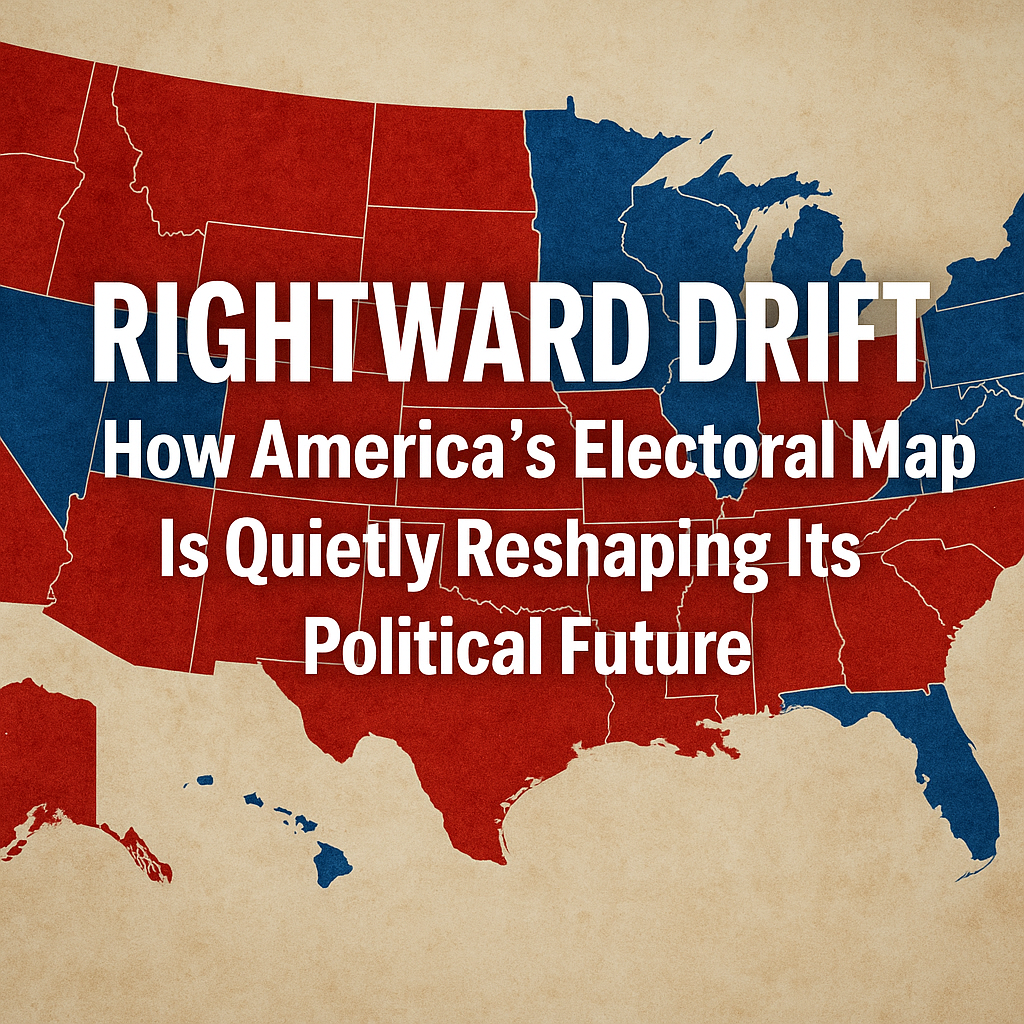FnF News
🇺🇸 FNF News | U.S. Politics & Demographics
Published: June 16, 2025
By: Khadija Khan
“Rightward Drift: America’s Political Center Shifts Amid Blue State Exodus and Demographic Realignment”
As the U.S. gears up for another contentious presidential election cycle, a striking trend is becoming harder to ignore: the center of American political gravity is shifting rightward. Contrary to narratives of a rising progressive majority, recent demographic, electoral, and ideological patterns paint a more complex—and increasingly conservative—picture of the nation.
This shift is being fueled by a mass migration out of blue states, an Electoral College system that favors rural and conservative regions, and a public sentiment that remains more moderate or conservative on major policy issues than many Democratic strategists are willing to admit.
The Flight from Blue States
Since 2020, millions of Americans have fled traditionally liberal states like California, New York, and Illinois in search of more affordable, secure, and politically aligned environments in red states like Texas, Florida, and Tennessee. According to the U.S. Census Bureau’s 2024 population report, over 3.5 million people made this move in just four years.
“People are voting with their feet,” said Dr. Meredith Lane, political geographer at the University of Florida. “This isn’t just about economics. It’s ideological. They want school choice, public safety, lower taxes, and a say in how their kids are raised.”
The motivations driving this migration are multifaceted:
- Rising crime and homelessness in urban blue hubs
- High taxes and soaring housing costs
- Contentious social and education policies
- Growing disenchantment with progressive governance
Demographics and the GOP Advantage
While Democrats continue to win the popular vote in presidential races, the real contest lies in the geography of support. The Electoral College, by design, amplifies the influence of rural and suburban voters—areas that are increasingly conservative.
In 2020, Joe Biden won with over 81 million votes, yet his margin in crucial swing states was razor-thin. That trend is expected to harden, not soften.
“Republicans don’t need a majority of Americans to win,” explained Dr. Todd Shapiro from Brookings. “They need a majority of districts—and the migration patterns are helping cement their grip on those.”
According to RealClearPolitics’ latest projections, if current demographic shifts continue, formerly purple states like Georgia, Arizona, and Nevada could revert to reliable red status by 2028.
Policy Pulse: America’s Right-Tilted Consensus
Even as cultural institutions—from Hollywood to higher education—promote progressive ideals, polling consistently shows that American voters lean right on many major issues:
- Immigration: 63% of Americans support tighter border controls (Pew, 2025)
- Public safety: 71% favor increased police presence in high-crime areas (Gallup, 2025)
- Education: A majority supports school choice and parental rights legislation
- Energy policy: Domestic fossil fuel production remains popular amid rising energy prices
“The media bubble distorts how mainstream many conservative ideas actually are,” said Eliana Brooks, policy editor at National Review. “It’s not that progressives are losing ground—it’s that they never had the middle.”
The Joe Manchin Paradox
Senator Joe Manchin of West Virginia, once a centrist thorn in the side of the Democratic Party, now increasingly represents the American mainstream. His stances on fossil fuels, gun rights, and fiscal responsibility were derided by progressives but applauded by moderates and conservatives alike.
“If Manchin ran for president, he might actually win more Republican states than Democrat ones,” joked political analyst Steve Darby. “That’s how far the center has shifted.”
In truth, what was once considered centrism—balancing economic freedom with social moderation—is becoming the new right. As Democrats veer further left, even figures like Manchin are starting to look like relics of a party that no longer exists.
The Rise of the Red State Model
Texas and Florida, often maligned in progressive circles, are booming by most economic and social indicators. Texas has seen a 22% increase in business relocations since 2021, while Florida’s job growth rate outpaces the national average by over 40%.
Governors like Ron DeSantis and Greg Abbott are not just riding the wave—they are defining it.
“The red state model isn’t just rhetoric,” said journalist Janice Houghton of the Wall Street Journal. “It’s real. People are choosing law and order, school freedom, and tax sanity over urban chaos and bureaucratic sprawl.”
This model is now being exported to other states such as Tennessee, Utah, and Idaho, which have seen similar growth and ideological fortification.
The Progressive Dilemma
For Democrats, the warning lights are blinking red. The coalition that brought Biden to power—a mix of urban voters, suburban women, young progressives, and racial minorities—is fracturing under the weight of inflation, immigration pressure, and culture war fatigue.
“People are tired of being told they’re wrong for loving their country or wanting their kids to have structure,” said voter advocate Marcus Lee in Pennsylvania. “Progressives underestimate how much Americans crave normalcy, not revolution.”
Final Thoughts: The Future Isn’t Liberal
Barring a radical shift in strategy, Democrats could find themselves locked out of the White House for multiple cycles. Cultural dominance doesn’t translate into electoral success if it alienates working-class voters, small business owners, and suburban families—the backbone of American politics.
As more Americans leave blue states behind and find their voice in red territory, the dream of a progressive majority looks increasingly like a coastal illusion. The numbers don’t lie. And neither does the ballot box.
Sources:
- U.S. Census Bureau (2024 Migration and Population Trends Report)
- Pew Research Center: National Attitudes Survey (2025)
- Gallup: Crime and Law Enforcement Polling (2025)
- RealClearPolitics Electoral College Forecast (June 2025)
- Brookings Institute: Electoral Analysis
- National Review, The Atlantic, Wall Street Journal, Reuters

